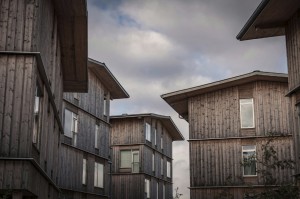Using timber in construction continues to gain popularity thanks to modern composites. Cross laminated timber (CLT) in particular has become a viable alternative to steel and concrete. Every year we see more projects choose to use it. We want to have a closer look at it today, including some of the most crucial details. Then, if you are planning a project and want to work with an architect in London, you can speak to us.
What is it?
CLT is an interesting material because of how it is made. What you have is individual timber boards. You lay them at a 90 degree angle and use adhesive, typically polyurethane, to bond them together. Applying hydraulic pressure creates strong, stable, products.
The great thing here is the number of boards can vary to suit the project’s specifications. There is always an odd number, starting with 3 at the lowest total. However, if you need more strength and load bearing performance, you could choose 5, 7 or 9 layers.
Advantages
 There are a number of fantastic advantages with CLT. It is a good idea to look at them and consult an architect in London to ensure you will see the benefits.
There are a number of fantastic advantages with CLT. It is a good idea to look at them and consult an architect in London to ensure you will see the benefits.
For one thing, the timber gives more flexibility with designs. You can cut it to shape and join it effectively. In fact, experts can do this on site with ease.
The timber is also much lighter if you compare to steel and concrete. That makes it easier to handle and means structures can often get away with smaller foundations. Ultimately, it can mean a faster build as well as cheaper construction thanks to using fewer resources.
Easily the biggest selling point with CLT is the environmental benefits. It can have a much smaller carbon footprint than other construction materials. Timber is also sustainable because trees can be replaced. Impressively, the carbon footprint of cross laminated timber buildings can be 35% less than structures with steel or concrete cores.
Two important considerations
If you are thinking about CLT, it is a good idea to ask an architect in London about the most important factors you need to consider. The first is fire proofing. It is a simple fact that timber is more vulnerable to fires than concrete or steel. However, the nature of CLT offers an advantage over traditional timbers. What happens here is the outer layer will char and protect the other layers. You can improve fire resistance with other additions too. However, you need to look at the fire regulations.
The second thing to think about is moisture. Timber will always be vulnerable and raise concerns about damp and mould. CLT sadly has the vulnerability too. What you need to do if you are using it for a project is ensure it is dry and remains that way. Don’t let it get wet, especially during construction, as it can lock moisture in the fabric of the building.
Discuss everything with an architect in London
Whatever kind of project you are planning, it is always worthwhile to get help from an architect. Their experience with different materials can be invaluable. It could help you to make your building more sustainable and better for the environment. It can also ensure you are aware of the challenges of particular materials.
So, if you want an architect in London to help you, contact us. We can look at all the crucial details and ensure you choose the right materials.
